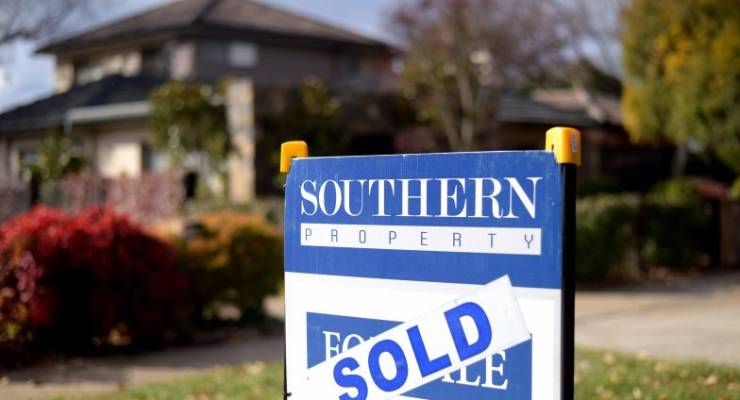
Property prices have moderated in our largest cities over the past year, thanks in part to tightening of lending by APRA, and on inflows of foreign capital. There is some respite for first-time buyers, but the picture for renters is mixed. This year’s federal budget had nothing significant for housing and those on lower incomes have little to celebrate in terms of housing reform.
Modest decline in average property prices, with exceptions
The past year has seen some important changes in Australia’s housing market. Property prices are no longer rising in most of Australia’s capital cities (with the conspicuous exception of Hobart) – but on average are down by 1.7% from their peak in October last year. This is a fairly small decline by comparison with other ‘corrections’ in capital city residential property markets over the past three decades, but it almost certainly has further to run.
In some cases – most obviously Perth and Darwin – the decline in property prices reflects a fall in the demand for housing associated with changes in population growth; in others – most obviously Brisbane – it reflects a significant increase in housing supply, particularly of apartments; while in Melbourne, continued strong population growth has kept a more solid floor under prices.
However, government intervention has also played a role in bringing about this halt to the previously inexorable rise in residential property prices.
APRA’s dampening of interest-only lending has slowed investors
In particular, the Australian Prudential Regulation Authority’s move in March last year to curtail interest-only lending (which had been particularly popular among property investors), coming on top of its earlier imposition of a 10% ceiling on the rate of growth in lenders’ investor loan books, has helped to slow lending to investors, from 49% of all mortgage lending in 2014-15 to 39% thus far in 2017-18.
Demand from foreign investors appears also to have moderated, probably less as a result of tax increases imposed by state governments (and in FIRB fees in last year’s federal budget) than as a consequence of tighter controls on capital outflows for property purchases imposed by the Chinese Government.
Some respite for first-time buyers
Reduced demand from both domestic and foreign investors has made it a little easier for first-time buyers to enter the market. Their share of mortgage lending has increased to 12.7% thus far in 2017-18, the highest in five years, from a record low of 9.8% in 2016-17. New state government measures directed at first home buyers, particularly in New South Wales and Victoria, appear to have helped a bit, although cash grants and stamp duty concessions usually don’t have a lasting impact (other than on prices).
Reflecting these trends, it’s also notable that the decline in average capital city property prices since late last year has been concentrated in high-end houses. By contrast, low-end prices have continued to rise, albeit at a more modest pace.
Mixed news on rental values
Meanwhile at the other end of the housing system, rent inflation has picked up over the past year in most capital cities other than Darwin (where rents have been declining for four years), Perth (where rents appear to be “bottoming out” after falling by more than 20% between mid-2013 and mid-2017), and Sydney (where the pace of rent rises over the past year has slowed to just over 1%). In Melbourne, rents have risen by more than 3% over the past year – faster than CPI or wages growth – while in Hobart they have risen by an eye-popping 12.2% (it now costs more to rent a house in Hobart than in Adelaide, Perth, Brisbane or Melbourne).
Housing was a particular focus of last year’s federal budget, and as I wrote here at the time, the measures relating to housing were ‘good in parts’.
Unfortunately most of the ‘good parts’ have yet to become operational – or in some cases even to be legislated.
Not much in this year’s budget to help the less fortunate
This year’s federal budget had nothing significant for housing. The word “housing” was mentioned only once in the Treasurer’s budget speech – and that was only in the context of a program for Indigenous housing in the Northern Territory for which funding will decline by 24% in the coming financial year. The budget provides $5 million over three years for the Australian Housing and Urban Research to continue its research program; $4.8 million over four years to the ABS to construct better estimates of the stock of affordable housing; and $200,000 to the Australian Institute of Health and Welfare in 2018-19 to build a ‘user-friendly’ dashboard of housing and homelessness data.
There’s also $15 million to “accelerate planning and zoning reforms to support housing supply in Western Sydney”, and a plan for the Australian Communications and Media Authority to sell off some land it owns in Brisbane to provide for “up to 400 homes”.
But that’s it.
In particular, the new National Affordable Housing and Homelessness Agreement with the states and territories does not provide for any increase in funding over and above what was in the expiring agreement (although it does provide greater certainty over funding for homelessness programs). It does not provide any relief for those states and territories (particularly Tasmania and the ACT) for whom a large proportion of the funding they get under this agreement is handed straight back to the federal government in the form of interest on and repayments of advances under previous agreements. And it has not included the previously foreshadowed requirements for greater accountability on the part of the states and territories for what they do with the funding provided under the Agreement.
Nor was there any increase in the level of Commonwealth Rental Assistance payable to pensioners and beneficiaries renting from private landlords.
So, in all likelihood, although would-be first-time home-buyers may find it a little easier to achieve their housing aspirations in the year ahead, low-income households looking for rental accommodation which they can afford will continue to find the housing market challenging and stressful.
This article was originally published at John Menadue’s Pearls and Irritations
Saul Eslake has previously been chief economist of the ANZ Bank, a non-executive director of the Australian Housing & Urban Research Institute and a member of the Rudd and Gillard Governments’ National Housing Supply Council.








How much of Hobart’s house price increases are due to “foreign” investment.
That is, people from Sydney and Melbourne investing in Hobart property at the expense of locals.
And how has the increase in the short stay rental market (eg Airbnb) affected the local rental market?
How much cross-over is there from “foreign” investors and the increase in short term rental properties?
Like Uber, Airbnb is the equivalent of the scab/strike breaker divide in society.
Everyone’s hand turned against the other.
Come on AR, there’s more to it than that. Swings and roundabouts. I have a granny flat attached to my house which I airbnb. A – I don’t have to put up with permanent rentals, B – I meet wonderful people from all over the world, C – It earns me enough to not be eligible for a pension and D – I don’t have to move from a home and region which I love. How am I a scab/strike breaker?
I was referring to the companies – currently exploiting you only (s)lightly but, as with supamarts, once the small/individual players have been crushed, there will be no constraint on their rapacious ways.
You will be next, enjoy it while you can.
Uber and Airbnb both use new business models that has changed the staid, cosy, lazy status quo. Not always for the better, but many would agree the taxi industry needed a shake up (their closed shop’s been shaking us down long enough). In our neck of the woods there’s a lot of holiday letting and I’ve previously dealt with a rental agency to get bookings and paid through the nose, now I pay 3% to Airbnb for a fabulous, easy to use booking system. It beats dealing with moody, expensive, up themselves Real Estate people thats for sure.
Great to see you get a run in Crikey Saul. The Budget was again for prosperously employed and the older self-funded. The young without a house were again left without help for their, and in fact OUR, future. We all recognise the massive problem of housing affordability for the young to all of OUR future so let’s do something about it. It is time for a return to direct Government funding on a large scale. In the US Freddie Mac & Fannie Mae are increasing funding for low rate rental housing. Australia needs to return to the strategy of both parties for most of last century and provide low cost housing for both welfare and low income households before we damage our society.